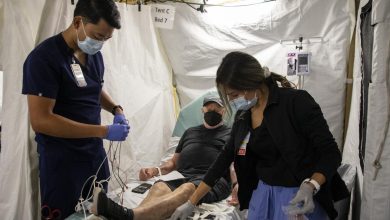Dermatologists Who Had Skin Cancer Share 7 Warnings That Can Save Your Life

Dr. Elizabeth Tanzi, a board-certified dermatologist, had a dark patch on her lower thigh during her first pregnancy. When the area started to develop six months later, the warning signs went up.
Being a dermatologist, she explained, “I had it biopsied and it was a melanoma. Any change in a mole could indicate developing cancer.” “Although I was very concerned at the time, being 37, the surgeon was able to remove it completely.”
More than nine thousand Americans are diagnosed with skin cancer each day, making it one of the most prevalent types of cancer. Dermatologists advise people to be aware of the ABCs of skin cancer (asymmetry, border, colour, diameter, and evolving) and to practise healthy sun safety. However, they also caution that there are other factors to take into account that may surprise them.
1. You can get skin cancer underneath your nails.
Even though Bob Marley, the father of reggae music, passed away from melanoma that began under his toenail, cancer still frequently goes undiagnosed in the nail area.
“The most frequent conditions we see under the nail are squamous cell carcinoma and melanoma,” board-certified dermatologist Jennifer Holman of U.S. Dermatology Partners Tyler said. Melanoma manifests as fresh, uneven, or shifting colour streaks along the nail and cuticle, whereas squamous cell carcinoma looks more like a wart under the nail.
The issue with this area is that many individuals are unaware that it can be something more serious because it closely resembles a bleeding wart, bruise, or fungal infection. Tanzi stated that as a result, cancer beneath the nail may have a very bad prognosis.
2. Just one session of indoor tanning can increase the risk of melanoma.
After seeing a shifting mole on her stomach, Holman was diagnosed with melanoma. She credits her extensive indoor tanning throughout her undergraduate years for her diagnosis.
According to Holman, “we know that women under 30 who use indoor tanning are six times more likely to develop early onset melanoma, and that even a single indoor tanning exposure can exponentially increase the risk of melanoma.”
The cause? Holman claims that indoor tanning usually entails high concentrations of UVA radiation, which raises the risk of melanoma in particular.
“UVA penetrates more deeply and increases that risk, but we typically think of UVB as the rays that cause sunburns,” she said. “The incidence of skin cancer is higher than any other malignancy in humans, but ultraviolet radiation is one of its primary causes, and it may be better understood than any other human carcinogen.”
3. Skin cancer in between the toes is particularly dangerous.
Even though it’s rare, developing skin cancer between your toes is a possibility, and a very hazardous one.
According to Tanzi, “melanoma has a very good cure rate when caught early; however, when it’s allowed to progress and spread down into the skin, it can be deadly.” “Melanoma on the bottom of the foot or between the toes is especially dangerous because it goes unnoticed for a long time and is allowed to spread, since people may not notice a changing mole in these areas.”
A board-certified dermatologist should be consulted if you discover a lesion that raises concerns, as around half of melanomas are self-diagnosed, according to the American Academy of Dermatology.
4. Sores or cuts that don’t heal could be a sign of skin cancer.
Melanoma, squamous cell carcinoma, and basal cell carcinoma are the three most prevalent types of skin cancer. Although the first two kinds are linked to sun exposure, melanoma can sometimes develop in situations where exposure to the sun is not present.
According to what patients tell me, basal and squamous cell carcinomas bleed more readily, said Holman. “Usually, when [it forms], patients think they have a pimple, an irritated hair follicle, or a bug bite, but they don’t heal and keep growing and bleeding.”
Recall that bleeding or non-healing skin lesions are never normal and may indicate a serious risk of skin cancer.
5. Not all melanomas follow the ABCDE rules.
Dermatologists generally evaluate skin alterations using the ABCDE rules: asymmetric spots, uneven borders, new or changing colours, a diameter larger than a pencil pencil, or spots that appear to be evolving. However, not all melanomas fit this description, according to Holman.
The most important thing to watch out for is any area that changes or doesn’t go away after a few weeks, even if you don’t know how long it’s been there. Sometimes they don’t even have any pigment at all.
Early diagnosis is important for the patient’s overall survival percentage as well as the aesthetics of the scar that is left behind.
6. Skin cancer can be mistaken for eczema or psoriasis.
Skin cancer can mimic benign skin disorders like psoriasis or eczema, especially in its early stages. Sadly, this resemblance may cause a delayed or incorrect diagnosis.
According to Holman, “I have patients who come to me believing they have a patch of psoriasis or eczema, but they can actually be superficial basal or squamous cells.” “Red, scaly patches can be the initial sign of both psoriasis and eczema (atopic dermatitis), but a board-certified dermatologist should be consulted if the affected area is not improving with conventional treatments or if it doesn’t heal or go away after a few weeks.”
7. Skin cancer can occur in all skin tones.
All skin tones are at danger for skin cancer, even those with darker complexion, even though those with fairer skin types are more likely to get it.
As melanoma is less suspected in darker skin kinds, it is generally diagnosed later, according to Holman, who recently performed melanoma excisional surgery on a woman with the darkest skin type.
According to Holman, “African Americans and Asians most frequently develop melanoma on the hands and feet, while about the same number of Caucasians and African Americans develop melanoma on the feet.” “This explains why melanoma with darker skin tones has a greater prevalence of morbidity and mortality because melanoma under the nails, between the toes, and on the bottom of the foot is commonly identified at a later stage and hence has a higher risk.”




